Previous Features
History - Beaver Island Train - February 2020
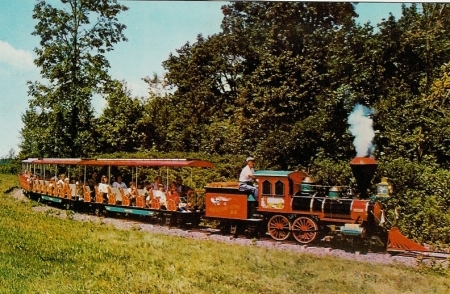
Story from "Abandoned Amusement Parks in New York". Website.
Grand Island Rotary Club members spent the better part of the spring of 1964 preparing the land and tracks for a miniature train that would travel around Beaver Island State Park. The train, station, tunnels, tracks and bridges were completed and opened to the public after a golden spike ceremony on Memorial Day, May 30, 1964. It was anticipated at the time that 25,000 passengers at 25 cents per round trip would be able to ride during the summer.
The railroad provided a ride of more than 1 1/4 miles in the Park. The station was close to the bathing beach and tennis court area. "The right-of-way proceeded west along the Niagara River through the picnic area, over the trestle at the lagoon and then through the woods and tunnel located on Beaver Island," an article in the local paper stated. Robert D. Beach, chairman of the Rotary project said at the time that the train station reflected the 1860 era to harmonize with the old-time 70-passenger steam-type train. The train required about eight minutes to travel the layout.
Extensive grading and the filling phase of the scenic railroad right-of-way was a big part of the project and included 400 tons of stone ballast put into placed. A 65-foot, all steel trestle was built over the lagoon entrance and a 120-foot tunnel was also part of the project. More than 15 tons of steel rail were delivered from Detroit for the track which was installed by a full crew of Rotarians under the supervision of Island resident Christ L. Kruse. The six-ton train was delivered to Beaver Island on May 20, 1964.
The local weekly paper reported on July 30, 1964, that, "Since opening day May 31, 1964, the Rotary's miniature train in Beaver Island State Park has carried 45,000 passengers." All profits went towards the Rotary Club's civic projects on Grand Island. Jack Houck, manager of M&T Bank at the time, was instrumental in securing a $30,000 M&T loan for the Club to help finance the $55,000 project. Additional funds were obtained by personnel loans. Dr. Norman G. Courey was the financial chairman of the project.
According to Bob Beach, this was the first train to be installed in a state park in the United States. Bob was a sales representative for Allan Herschell Co. in North Tonawanda who manufactured the train. A very active member of Rotary at the time, he said that almost all Rotarians had a hand in this train project, either in financing, construction or actual operation. "I devoted a two-week vacation to supervising the track layout, construction of the station and storage tunnel and installation of the train," Bob said. "Time has dimmed my memory but there were many individuals involved," he said.
The train continued to operate in Beaver Island State Park for several years and was eventually sold to Fantasy Island.
CCC Cabin FREE for the Taking
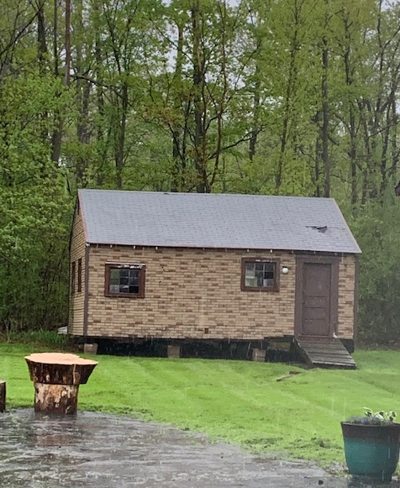
Current photo of possible CCC cabin.
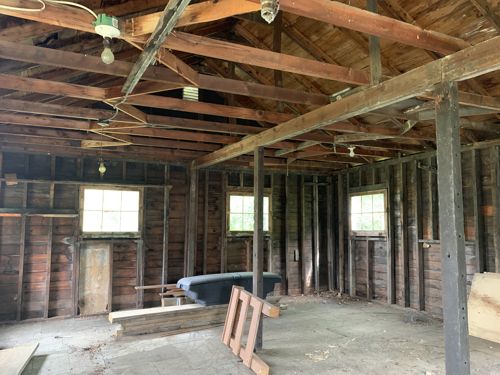
Interior of cabin.
Written by Maureen P. Phillips, Ph.D. - Captain, USAF/ANG (Retired)Seven decades untouched, unmoved, and mostly unnoticed, this cabin seems to say that it was placed here in a repurposing move after the Civilian Conservation Corps closed up shop in Grand Island, New York, on July 2, 1935. Do you know anything about it?
It became mine last year on December 20th, 2018, when I purchased the property on West River Road where it has sat for more than 70 years. I've been renovating inside and outside of the front cottage on the property since then, a building that originally sat on the river shoreline and has seen multiple renovation efforts. With exterior paint nearly dry, it's time to find this beautiful wooden monument to hard work a good home.
I have photographs of the structure on my property dated October 1, 1949 (see above), and anecdotal evidence from neighbors (thanks Mr. Pedlow!) that it was moved from the CCC site by the original owners, John and Margaret Hankins. Between that and comparisons of the cabin's interior to documentary film of CCC structures, I'm convinced. Nevertheless, photos from the Grand Island, Buckhorn State Park/Beaver Island State Park project show much longer barracks than this cabin--it's just 24' long, 20.6' wide, and 13' tall. I suspect it was used as an office. The fact that its 480 s.f. has 7 total, original (top-hinge-type) windows tells me that it may have been used as a project office, and that, perhaps, those windows were propped open to offer a ventilating breeze. It has a door front and back on the same end of the cabin, as well, suggesting that quick passage through it was important.
Maybe the men shuffled through those doors in line to receive their $30.00 monthly wages? It's difficult to fathom how $30.00, earned by the labor of young, single men clearing land on Grand Island was a life line to so many families, but it was. Part of the Works Project Administration, the Civilian Conservation Corps gave hope to men at a time when the unemployment rate was 25 percent. It's staggering to think that one in four American families had no means of earning their food, clothing and shelter until the WPA and multiple infrastructure improvement projects across the country contributed to stimulation of the economy and got America back on its feet following the Great Depression. Did you know the men had a military training commitment included in their CCC service? The camps were modeled on military discipline and order.
After two earnest attempts to rally enthusiasm for it from the NYS Parks Preservation office, I recently placed an ad on Craigslist entitled "Free Tiny House". Intense interest has followed, and especially by those who appreciate its nearly 100 year old lumber and the fine craftsmanship you simply don't see anymore. Thus, if you have any interest in acquiring the cabin, you'll have to write to me soon. As I have said to those who are calling, the first person to arrive with the means to move it, takes it for free. Call me crazy, but I like the idea that someone would invest in having to place it where they are, simply because of what it is. I don't need to sell it (and probably couldn't), but I definitely want someone who either needs a home, or appreciates its intrinsic value, to work hard to take it to its next spot. Ideally, it will remain here on Grand Island as a reminder of our link to the industry and hard work brought here by the CCC crews.
My guess is that its aromatic lumber and "beefy" craftsmanship (as Tom Rall said it) place its value at approximately $5,000, possibly what it might cost to move it out (less if it remains on Island). In my initial reno stress and ignorance, I asked Grand Island Fire Chief Matt Osinski to come by one day, thinking that a controlled burn would solve the fact that it divides my property at the tree line, just where I'm about to purchase more land. Chief Osinksi declined, but how much better, I soon realized, to find someone who needs and wants it! After all, there is booming tiny house movement underway and a shameful housing shortage for low-income families. Think of the similarities between the folks who built it and the ones who'd want to labor over it again to live a simple life.
Island Dispatch stories from the CCC project period and afterward, stories from neighbors, and even archival newsletters written by the CCC men of Grand Island themselves, all tell the history of how our town, Grand Island, New York, where I had longed to return throughout my 30-year professional career, became the beauty that it is. This relic of the Civilian Conservation Corps has sat silently, unchanged by the tumult of decades passing before it--the move of the front cottage from the river shore to make way for West River Parkway, Buckhorn and Beaver; families who've moved on and off the property over seven decades, surges and crashes of economic security; the war's end, other wars begun; bad hair styles; 14 presidents - some honest, some not; scorching summers; the epic Grand Island blizzard of 77' and 69 more; men landing on the moon, a doubling of Grand Island's population by the Baby Boom generation, ...that cabin has been right there all along, a silent witness to human effort. It's the epitome of staid, given it's just a bunch of wood carefully placed by human hands. I wonder who else can fill in the blanks on the story of the cabin?
Yesterday morning a doe and her triplet fawns stepped out from behind the tree line just beside the cabin to saunter around the lawn....a poetic contrast of lovely new and beautiful old that helped me start my day. I look forward to your comments about the cabin and any information about the GI CCC you may have. Feel free to write me at maureen.p.phillips@gmail.com and use "CCC GI" in the subject line so I'll know the origin of the message.
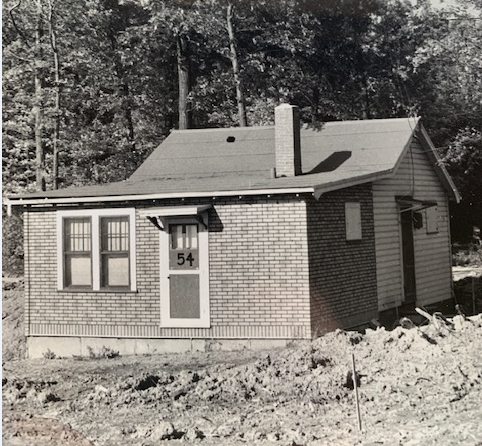
1949 photo of current residence, notice the resemblance to cabin.
Imagine Buffalo without the Buffalo Bills - February 2018

From left: Fahim Mojawalla, author Ron Zoeller, publisher Mike Billoni.
BUFFALO, NY - Ron Zoeller, a Buffalo native, entrepreneur and founder & CEO of North American Health Plans, has released his memoirs, "All In". The 360-page book contains more than 120 photos and inspirational quotes from business, military and sports leaders.In 1998, he was the Vice-Chairman of Business Backs The Bills. Ron was a front-runner calling for community action to prevent the Bills from leaving Western New York. His new HMO had purchased the naming rights for Buffalo's downtown baseball stadium when it was called North AmeriCare Park and in two decades he built that company from launch to revenues of $50,000,000 and hundreds of area employees. Interestingly, Grand Island plays a role in this book on three fronts:
* - The book talks about how Ron and his father purchased what is now the Riverstone Grille on East River Road on Dec. 4, 1980 and operated Z's Island Inn for three years. It was Von's Inn when they bought it from Jean Von Wryeza for $1,000 down on a $98,000 purchase with a 10-year mortgage.
* - The book publisher and critical editor is Michael J. Billoni, Managing Partner of Billoni Associates Publishing.
* - The fulfillment of the mail order sales is being handled by Fahim Mojawalla, owner of the Island Ship Center, 1879 Whitehaven Road.
Zoeller will hold a book signing in conjunction with the Island Ship Center at Momma De's Mixing Bowl, 1879 Whitehaven Road, Grand Island 14072 on Saturday, March. 10th from 10 a.m.-1 p.m. Books cost $20 and Zoeller will donate $5.00 from each book sold during the event to the Grand Island DECA program. Everyone purchasing a book will receive a raffle eligible for a variety of prizes. "Island Ship Center has done the fulfillment for a number of books but this is a unique project because it's the memoirs of a successful businessman who once owned a business on Grand Island," Mojawalia said.
Taking him more than 1.5 years to write, edit, and produce, "All In" began as a legacy for his kids and grandkids before he focused on community events with which he was involved over the years. The book is available for $20 on line at www.azeros1.com or locally in the bookstores at The Buffalo History Museum, 1 Museum Ct., Buffalo; Burchfield Penney Art Center, 1300 Elmwood Ave., Buffalo; the Buffalo & Erie County Naval & Military Park, 1 Navel Park Cove, Buffalo; Ilio DiPaolo's Restaurant, 3785 South Park Ave., Blasdell, and Talking Leaves Books, 951 Elmwood Ave., Buffalo.
Written in an attention-captivating narrative, "All In" will take you through a journey of Ron's stories:
* - His role as Vice Chairman of Business Backs the Bills, and behind-the-scenes dealing with then Bills' owner Ralph Wilson, COO Jeff Littmann, and former NFL Commissioner Paul Tagliabue.
* - How his then unknown company, North AmeriCare, purchased the naming rights of the downtown baseball stadium.
* - How and why he brought members of the Cleveland Browns' Dawg Pound to Buffalo for a New Year's Eve weekend playoff game against the Miami Dolphins in 1995.
* - Bills' former QB Doug Flutie, Ron's 1,000,000th box of Flutie Flakes, and how Ron's dogs Flutie and Flake and the American flag became the centerpiece of a Wegmans' Patriotic Pets promotion.
* - Attending school in the '50's and '60's in the Maryvale School system in Cheektowaga and at Kent State University, where the Ohio National Guard killed four students and wounded nine, including one of his fraternity brothers.
* - How his and his wife's many community and charitable activities led to a relationship with NHL Hall of Fame Coach Scotty Bowman and his wife, Suella.
* - How he purchased the Stage One night club in Williamsville owned by the controversial movie mogul Harvey Weinstein who then owned Harvey & Corky Productions.
Ron currently owns and operates Azeros, a health care consulting company. He resides in Orchard Park with his wife, Fay. All In was published by Billoni Associates Publishing, Michael J. Billoni, Managing Partner, and printed locally through RMF Print Management Group in Lancaster.
Alice Gerard - Council Interviews - November 2017
Island resident Alice Gerard is a freelance writer/photographer/artist and master gardner. She has a blog titled "Alice's Grand Adventures" and in the past few weeks she interviewed the Town Council candidates. You can see her very informative interviews with Jennifer Baney, Cyndy Montana, Celia Spacone and Pete Marston . Thanks for sharing Alice!
Wildcat Roller Coaster History - April 2017
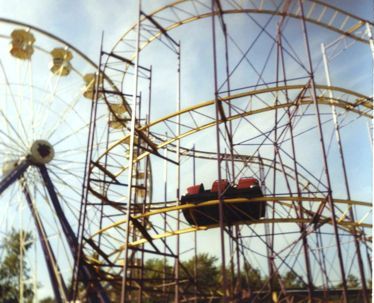

Photos courtesy of Sara Zielinski of Niagara Falls.
Story by Logan Benjamin
The Wildcat at Fantasy Island operated for 30 years and throughout that time, probably entertained millions of Western New York residents and amusement park enthusiasts. One of those enthusiasts was me...I'm Logan Benjamin, president of the WNY Parks Group, an up and coming amusement industry community that caters to a worldwide audience. I was one of the last riders as it closed down in 2004, and it was eventually replaced by the Crazy Mouse one year later. Around the time Wildcat "deconstruction" and Crazy Mouse construction progressed, I joined the amusement industry and started studying it full time...at 6 years old. Now celebrating my 13th year in the amusement industry, at 18 years old, I'm currently the president of the WNY Parks Group. Part of my site is a history based section called the "Park/Ride Guide", which will eventually expand to feature almost every park and every ride to have existed.
But the story doesn't end there...I was incredibly curious as to what happened to the Wildcat after it was removed, from either being relocated to being a distant memory. In a further expansion of that section, I started an investigation to try and find the former coaster. After just one email to Zamperla, the manufacturer of the Crazy Mouse and a few other rides that are at Fantasy Island, the answer was discovered.
After Zamperla USA bought the Wildcat from Fantasy Island, there were rumors of its relocation to Russia. I even found a few videos of other models that operate internationally, but none of them were the one I was looking for. Just a few days into the investigation, the president of Zamperla USA personally responded to our email and told us that the relocation was untrue and it was scrapped upon its removal. While it wasn't the outcome we were anticipating and hoping for, it completed our investigation and furthermore completes the history of the ride. A page detailing the history of the Fantasy Island Wildcat will be on our website, www.wnyparksgroup.com in the future.
AUTHOR'S NOTE: According to the Roller Coaster Database, there are currently ten Schwarzkopf Wildcat coasters in operation, 4 in the USA. Some former Wildcat coasters were located at famous parks like Cedar Point and Busch Gardens. (www.rcdb.com)
Adam Taylor, Always A River Rat - September 2016
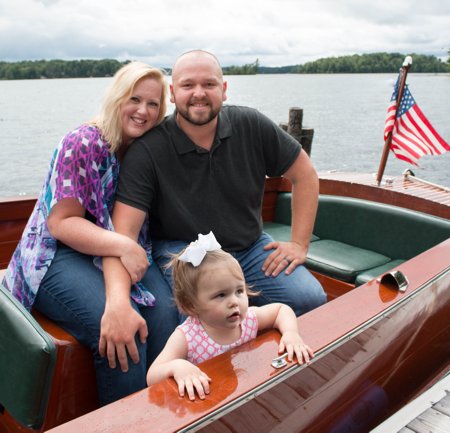
Adam Taylor with wife Rachel and daughter Reagan.
Former Island resident Adam Taylor has had an interesting career path. Adam came to the Island as a teen with his family and has a dock on East River, at the foot of East Park, where the family lives. Following is his story.One of my earliest childhood memories was back when my father Richie Taylor and his business partners; Tom and Pete Hayes purchased the "boathouse". The boathouse is the house that is built on piers above the water, just downstream of the South Grand Island Bridge. It was sold a few years ago and is much nicer now than it was back when I was a child, but we always threw enormous parties and we always had a boat or two to play with. As long as I can remember, we were always either working on the dock or going for rides on the boats. When I was 11 years old, my parents purchased a Jet Ski. We kept it at the boathouse (Tom'' home at that point). Obviously at age 11, I wasn't allowed to drive it right away, but back then, all you needed was a basic boating license and a child could drive a Jet Ski by himself. I took the safe-boaters course in North Tonawanda and at age 12, I was circling Grand Island all by myself. I was a river-rat from then on.
First job, I wanted to be on the water, saw an ad for the Grand Lady looking for a college kid, I was 16 but applied anyways. I spent three years on deck and had enough time to get my 100 ton master's license. Worked my way up to Captain in two more years. I worked as a regular captain for three years and then just filled in on occasion for an additional 3 years while I worked with my dad at his business. Andrew Deegan (son of Rick Deegan who owns the Grand Lady) brought it to my attention that I likely had enough time running the Grand Lady as captain to qualify for a 500 ton master's license upgrade. He had enough time himself and was looking for a friend to go through the process with. I studied for almost a year with him before testing at the Coast Guards Regional Exam Center (REC) in Toledo, OH. Passed the test (most difficult test of my life) and received a 500 ton masters license.
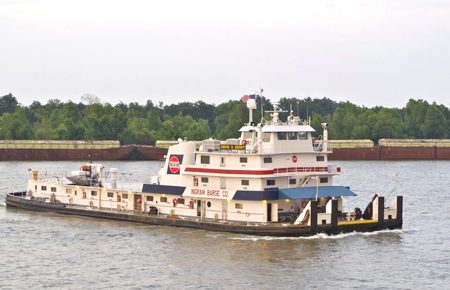
Adam's current boat on lower Mississippi River.
I was interested in pursuing a career on the water. I researched the type of jobs available for a 500 ton master and found very few. I did discover a massive industry in inland towing. The license requirement was calling for a master of tow, which wasn't too far of a step above my 500 ton license. I only needed to get experience on a towboat and get a Coast Guard qualified towboat captain (called a designated examiner) to let me steer a towboat and perform a series of maneuvers in different situations (this document is called a Towing Officers Assessment Record or TOAR). This is typically performed over the course of a year or two.Once I had my plan in place, I started applying to towboat and tugboat companies. What I had not expected was the complete lack of interest in my 500 ton license or my college degree. Either the companies didn't understand what I was talking about (because my plan for upgrading was not conventional) or they wanted someone with experience. After about three years of no success, I came to the realization that I needed to start at the bottom again and get my foot in the door. I moved to New Orleans and immediately got hired by Ingram Barge Company as a deckhand (Ingram Barge Company used to be part of the same company as Ingram Micro before Ingram Micro went public - fun fact). My job was to clean the boat and wire barges together in the hot southern Louisiana weather. Possibly the worst job in the world. It's difficult, uncomfortable, dangerous and you're away from home for a month at a time.

Fully loaded.
I did this job for three years. In my offtime, I spent my extra money on training certificates and trips to the companies main operations office in Paducah, Kentucky, where I would schedule appointments to discuss my application to the companies apprentice program. During this time I found a company in Albany to help with my license upgrade to Master of Tow (an unlimited towing license). I was accepted to the companies apprenticeship program and completed my apprenticeship in a little over a year.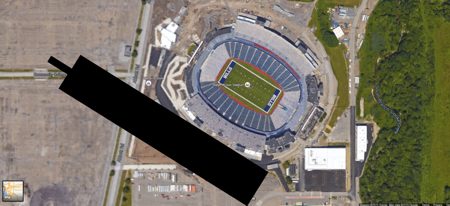
Size comparison; Towboat fully loaded compared to size of New Era Stadium in Orchard Park.
Now, I am the pilot on a line-haul towboat on the lower Mississippi River. My boat is 180 ft long, 50 ft wide with 3 locomotive engines (General Motors EMD 16-645-E7B is the type of engine), 3 8-ft diameter 5-blade propellers and 9 rudders (6 of which are called flanking rudders installed in front of the propellers for backing). We typically have two pilots (one drives while the other sleeps), an engineer, a cook, 6 deck-crew and either a jr. engineer (apprentice) or a steersman (apprentice). A typical tow consists of 35 to 49 barges (each barge is 35 ft wide and 200 ft long). A 49 barge tow is made up 7 barges wide by 7 barges long. When the boat is faced-up to this tow, we are 245 ft wide and 1,580 ft long. Size comparisons include the Willis tower in Chicago on its side or about 4 times the footprint of the Titanic, or about 8.5 acres. We typically haul coal, grain, corn, steel, salt, sand, concrete, fertilizer, chemicals, petroleum products and also some large finished products that need to be transported. A large 49 barge tow can hold the same amount of cargo as 2,500 semi-truck loads. If you do the math by the tons per mile, this is the cheapest, safest and most environmentally friendly means of cargo transportation in the world. Its also one of the few industries where someone can earn a 6-figure income within a few years with no college education. The truth is that I saw the opportunity to make a decent living with 6 months off per year.United Nations Plan - 1946
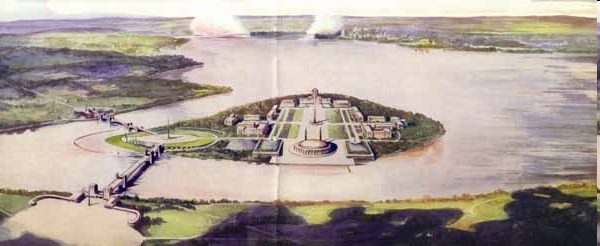
Rendering of U.N. headquarters on Navy Island.
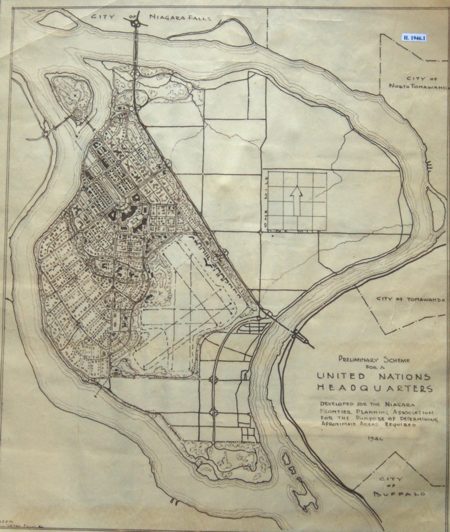
Map from 1946 titled "Preliminary Scheme for a United Nations Headquarters"
Click for larger view.
By Jodi RobinsonIn the Grand Island Wikipedia entry you can find the following; "In 1945, Grand Island was part of a plan to make a new World Peace Capital on the international border between Southern Ontario, Canada, and Western New York. The plan proposed placing the United Nations headquarters on adjacent Navy Island (Ontario), which was considered an ideal location because it lay on the boundary between two peaceful countries. An artist's rendering of the World Peace Capital showed the property with bridges spanning both countries (at Grand Island in the US and the Canadian mainland on the other side). The proposal was ultimately turned down in favor of the current U.N. headquarters in New York City."
If you delve a bit further, you will find no mention of this from the history of the United Nations, but you can see for yourself that some thought went into it by the map and rendering featured above. The map shows a bridge from Grand Island over to Navy Island that would have been close to the west end of Long Road. The western portion of the Island was space for housing, amenities and the large space in the center looks to be an airport. The map captian read "Developed for the Niagara Frontier Planning Association for the purpose of determining approximate areas required". The eastern portion seems to follow the I-190, the southern portion, Fix Road.
Isle Eyed For UN Site, Island Dispatch - January 20, 1989
by Marion E. Klingel (taken from newspaper story of January 1946)
The year was 1946 when an international committee, seeking a site for the proposed United Nations Organization headquarters, considered having it constructed on Grand Island. A statement sent to the Preparatory Commission, citing the advantages of the Island, pointed out the town "offers the required facilities in a region rich in historical and cultural associations . . . and would have as a site for the United Nations Organizations a dignity and character of its own." (Developers, please note!)
"Placing it on Grand Island (and/or Navy Island) with its two connecting bridges, approachable as it is through either Canada or the United States, very definitely permits the retention of whatever international character the members of the UNO may wish to preserve or develop," the Commission stated. Also, "It is believed that if desired, temporary buildings and homes could be erected on Grand Island as quickly and probably more quickly than at almost any other site. The land is generally level: excellent highways permit prompt access to any section. Only a few farmhouses and small summer cottages - none of any size - would have to be razed. Water, natural gas and electrical facilities are immediately available and sanitary equipment could be installed very quickly.
The report went on to mention, "Adequate and suitable temporary accommodations for meetings, assemblies' committee rooms, staff offices and living quarters are immediately available in the City of Buffalo and in other localities throughout the Niagara area which can be used until the permanent buildings are constructed and become available on Grand Island and/or Navy Island. The statement was signed by Roy H. Davis, Chauncey J. Hamlin and John A. Williamson for the international committee.
Marion E. Klingel's personal comments on the subject.
Marion E. Klingel served as town historian for Grand Island, N. Y. from 1962-1998.
Actually, Grand Island in 1946 could boast of more than "a few farmhouses and small summer cottages." Two subdivisions, Sandy Beach and Grandyle Village, had been developed within the ten years prior to 1946. The advent of Sandy Beach in 1938 and Grandyle in 1942 resulted in a population increase from 626 in 1930 to 3081 in 1950. Summer homes in Ferry Village and along east and west shores of the Niagara River had rapidly been converted into year 'round residences. And plans for doubling the capacity of the town's one school, Charlotte Sidway, were on the drawing board and a second school, Kaegebein, opened six years later. Nevertheless, the United Nations venture, like erecting a bridge from Grand Island to Canada and having the New York Central run railroad trains across the center of town and into Canada, became just another dream that never materialized.
Kali's Spirit Inspires Love Fest Fundraiser
Buffalo News Story by Gene Warner...See story.There is a fundraiser on Friday, March 27th at the Pearl Street Grill from 7:00 p.m - 11:00 p.m. Proceeds from "Love Fest" will go to help support the Young Adult Program at Roswell Park that Kali Mordaunt Korzelius helped found before her death in September of 2012.
The Great Northwest Adventure
By Amy E. MorganYou know you're onto something when you've spent 17 days with your spouse of 31 years; traveling three thousand miles by car through 6 states and both admit you'd happily keep going.
This May was our second extended two week vacation car trip. Why? To unwind, reconnect away from the commitments of work and home life, and to explore new areas of the U.S. Having lived in the 14072 all our lives, we're scoping out places we might eventually retire to or see if traveling itself fits our idea of retirement.
This year began in Omaha, NE for the Berkshire Hathaway Annual Shareholders Meeting, and extended West through South Dakota's Badlands, Mt. Rushmore and Sturgis, Wyoming's Devil's Tower, Yellowstone, and Estacada, OR to catch up with a friend from high school and wrapped up with a few days in Seattle, WA, before we flew home. It's tough to answer the most often asked question, "What was the best part of your trip?" Everything complimented each other. The four bed and breakfasts - each with a unique offering, personality and history, the leisurely drive with the luxury of time to chat or share a companionable silence, the roadside naps, the private jokes, the beauty of the landscape and variety of wildlife are hard to separate from each other.
I keep a log during our travels. Short snippets of our day, places reached, unexpected views, laughs, meals and the occasional solution to world peace we might stumble upon over a bottle of wine. Seventeen days of travel is a good chunk of time and the log is a pleasant way to nudge my memory. There are those parts that fall into the "best of" categories though. The trip started with a dessert that would leave all others on the trip in the dust. After dinner at Gorat's steak house, in Omaha, NE., our waitress Victoria offered up Blueberry Bread Pudding, which she promised as "life-altering". And it was. Wow. She delivered a square white plate with three warm slices of bread pudding dotted with blueberries next to a scoop of vanilla gelato. The bread's soft center and crunchy top complimented the smooth cream while the egg custard, spiced with cinnamon, nutmeg and vanilla held strong next to the tart blueberries. Our one serving was plenty for the both of us and not a crumb was to be found on the plate when we were done!
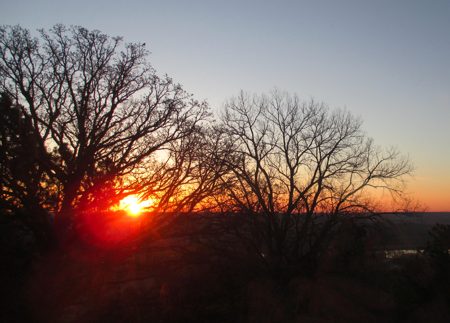
I enjoyed the most spectacular sunrise at the White Deer Retreat in Omaha, above. Ceiling to floor glass windows made three of the walls of our room and offered a panoramic view of the Missouri River Valley. This particular sunrise rose on what would have been my mom's 85th birthday. From bed, I watched (and took pictures) as the day appeared, stroking the valley below in ribbons of red and yellow. Mom and I shared a love of morning and it was a lovely way to remember her.
Philip and Amy Kruse run the Circle View Guest Ranch, a working 3,000 acre cattle farm located just 6 miles from the heart of Badlands National Park in South Dakota. It was by far our favorite bed and breakfast. After a slow drive through desolate yet strikingly colorful canyons, ravines and gullies of the Badlands, we came to the ranch entrance, a half mile drive up a summit to the house, located on the top of a butte. Halfway up, we stopped while a half dozen grazing cows and their calves crossed the driveway to continue their meal on the other side. Phil's adorable young daughter Katie helped with check in and immediately wrapped Steve around her little finger. Our room on the backside of the house overlooked the White River, the Badlands and the ranch of Phil's brother. Mornings found us feeding free range chickens, collecting eggs from the hen house and after Katie volunteered me, feeding a calf who'd been orphaned at birth, with a gallon sized milk bottle, sucked down in about three gulps. Phil and Amy shared stories of ranch life and their extensive knowledge of the Badlands. Our days with them began with breakfasts that included eggs benedict, ranch honey, homemade blueberry/almond granola and white chocolate raspberry scones with vanilla/blackberry butter. Plenty to fortify us for a few days of hiking and exploring.
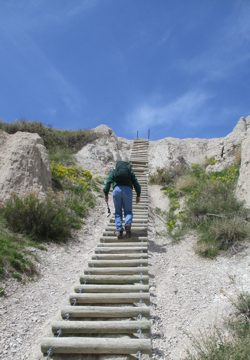
We sought out the Notch trail in the Badlands, 1.5 miles of dirt with a steep wooden ladder of 50 rungs bolted to the canyon wall. The hike abruptly ends at a cliff that drops steeply into the badlands to the south, with a miles long view of the colored ribbons of the White River Valley and the prairie grasses below. Sitting in the solitude and soaking in the view made the heart pounding trip up the rung ladder not only worth it, but left us feeling empowered enough to tackle it on the way back.
The easy-going luxury of time followed us after the Badlands. Following the suggestion of Frank Sanders, our upcoming Devil's Tower host, we chose the scenic drive of the Needles Highway and the Iron Mountain Road to Mt. Rushmore instead of the interstate, described by Frank as the "armpit of America". It was worth every minute of the extra time. Needles Highway was 14 miles of sharp turns and low single lane tunnels blasted through sheer granite walls that wound through Custer State Park. In Custer, we took a side drive through the wild game loop and were rewarded with spottings of deer, moose, bison, prairie dogs, antelope and burros.
Culminating at the entrance to Mt. Rushmore, Iron Mountain Road was 17 winding miles through pine trees and forest. We crossed wooden bridges and passed through a few more one-lane tunnels that perfectly framed Mount Rushmore. The daylight hours ran short, so after Mt. Rushmore we headed to Sturgis, SD, home of the Sturgis Motorcycle Rally. Home, that is, in August; in May, it's more of a sleepy rental town. Sans riders and their bikes on the rainy day we were there, it still provided entertainment as we browsed the Sturgis Museum gift shop and for us, the main attraction in town, the local Harley Davidson store. We left with a shot glass souvenir and headed across the street to a shop called "Hot Leather", where I was sure we would find a pair of Sturgis boxers for Steve. Alas, not a pair of boxers there, (nor anywhere in Sturgis that we found) a definite miss on the marketing we thought!
We stayed a short drive outside of Sturgis in Deadwood, SD at the 1899 Inn, a Queen Anne-style house built in 1899. We asked our host Laura Floyd, for dinner recommendations and she steered us a short five minute walk to the Deadwood Social Club above Saloon #10, a great restaurant with a variety of top notch dishes and an excellent wine list. Story has it, the DSC was a house of ill repute, until it was closed down...in 1985! We went with Laura's suggestions and ended up with the best meal we've had in our lives to date. I had the Smoked Tuaca Pheasant, lightly smoked South Dakota pheasant accompanied by mushrooms & sun-dried tomatoes in a Tuaca (Italian brandy with vanilla and citrus essence) cream sauce over fettuccine. The richness of the cream and pheasant were perfect against the earthy mushrooms. Steve chose the Pork Osso Bucco, a 22 oz. shank slowly braised, with an Italian mirepoix, on a bed of wild rice pilaf. It fell off the bone when you touched it. A full bodied bottle of Cabernet Sauvignon paired beautifully with our meal and we finished with the homemade chocolate cheesecake with chocolate chips. A meal to remember.
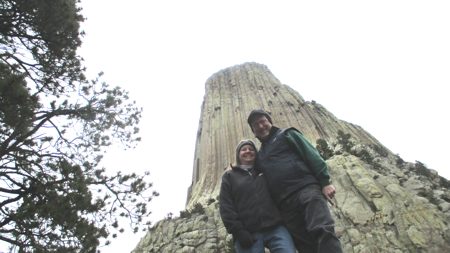
A little over an hour's drive the next morning took us to Devil's Tower, Wyoming, America's first national monument. Most certainly not the place to give credit for our best meals, but with a hike that outshone all others. Next to the Devil's Tower Lodge where we stayed is the Joyner Ridge Trail. Devil's Tower was a bit lower in the park from this viewpoint and the trail offered landscapes from meadows to forests. It was a cold, sunny, crisp day with no wind and our early May arrival ahead of tourist season gave us the trail all to ourselves. We were wrapped in silence as we watched eagles soar and deer graze on early spring meadow grasses. Sharing the lodge with us were four rock climbers. They were there to map out 30 feet of the climb on Devil's Tower to recreate it for their boss's indoor rock climbing wall with a budget of $200,000 just for the holds!
Just before our arrival at Yellowstone the next evening, we came upon a group of mountain goats scampering on the rocks at roadside. It was the introduction to the abundance of wildlife we'd only hoped to see during our stay at Yellowstone. Our three days there included stays at the Mammoth Inn as well as the Old Faithful Lodge. We encountered heavy, wet snows and warm spring-like days.

There's no denying that Yellowstone held the most memorable animal sightings: a herd of 70-80 Bison, Bears, Pelicans, Osprey, Ducks, a Bobcat, a Coyote, Elk, a Marmot (above) and the largest Ravens on earth! A leisurely mix of hikes, Geysers, sulphur pools, waterfalls, and stunning scenery blended with lots of laughs and good conversation. We stopped the car often, turned off the engine and listened to the creaking trees, calling birds, and trickling streams. A nap or two beckoned and we heeded the call. Although Old Faithful performed "on time", the talking groups on the bleachers set up at the perimeter were a bit distracting.
Our bed and breakfast after Yellowstone was the Idaho Heritage Inn, in Boise. And having stayed there, we can now boast to have stayed in the same B&B as one of our favorite people in the world, Mr. Rogers! We opted for one of our favorite travel dinners, which is to order a single dinner from the best steak house in town and share it in the room. Chandlers, only a couple miles away, prepared a to-go meal of warm spinach salad, Kobe steak, asparagus with hollandaise, mushrooms and Grand Marnier Chocolate Mousse for dessert. After dinner we walked the neighborhood while Steve enjoyed a cigar. Back at the Inn, we enjoyed a glass of wine and the Chocolate Mouse as we relaxed in rocking chairs on the front porch - like something out of a travel brochure.
The trip wrapped up with four days split between Oregon and Seattle. In Estacada, Oregon, we met up with a high school friend and enjoyed dinner at her favorite Thai restaurant, talking for hours about our lives on Grand Island "back in the day", the directions our lives took us, relationships and our children. She was a purposeful stop on the trip and was without a doubt, one of our favorite evenings.
We arrived in Seattle a little later than planned due to an unplanned stop for a couple hours to Mt. Rainier. The bottom of the mountain was decorated in small yellow wildflowers were in bloom and the top, at Paradise Point where we we'd hoped to hike, was totally snow covered. Halfway back down we stopped at Longmire and hiked the Wonderland Trail, a wooded area which followed along the river/stream not yet flowing strong with the Spring melt. We found Seattle about 15 degrees warmer than usual, bright sunshine instead of rain and an abrupt return to "city life". There were people, cars and buildings everywhere. Over our 2 1/2 days, we visited the Seattle Space Needle, Chihuli Museum, Bullitt Center, Pike Place Market and walked the Capital District the Neighborhood around our B&B, the Seattle Hill House. It was our first time to Seattle and although we enjoyed it, we missed the open spaces, the wildlife sightings which had almost become routine and the relaxed pace of the previous two weeks. (Since our return, the Seattle Hill House has closed.)
So whether we're fine tuning our vacation style or developing a retirement lifestyle is still up for debate. What's not is the ease and joy we find in each other's company, the thrill of exploring new places and the desire to get back out on the road. The research's begun and next year's adventure awaits.
Happy Ending For Angel and Family
By DiAnne George - 10/2/13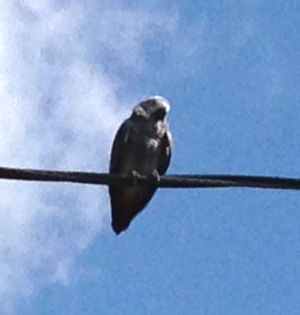
This is Angel (I learned later in the story) on the telephone wire near Burger King on Grand Island. She struggled to get up that high, which is what caught my attention when I was pulling out of Wendy's. I saw a bird that I knew immediately was a Parrot working hard to fly from the ground to a very high telephone wire. I turned around and went back to Burger King where she was to check out what kind of Parrot needed a little help. I grabbed my cell phone and started taking some pics and talking to the Parrot very high in the sky. After talking to Angel for awhile she started to talk back to me with little chirps. She just wasn't overly interested in me.....I thought. I started to walk back to my car to make some calls for assistance and when I turned my back Angel flew down from the telephone and landed on my shoulder. Somewhat startled, but not afraid, I quickly realized that this little lady was sweet. She wasn't going to let me leave without her!
I stood by my car for awhile with Angel on my arm....not sure what the next steps should be. I started emailing my friends back at work and posting pics on FB in hopes that someone could connect Angel with her owners. I decided to see how she would do in the car. She didn't do too bad. A little scared, but as long as she was close to me she was pretty calm. I decided to try the GI pet store, but once I was there my instincts led me to take her home and reach out to Pet Finder and WNY Rescue instead of leaving her at the pet store. Angel spent the majority of the car ride on my shoulder......I can only image what people thought seeing a lady driving down the thruway with a bird on her shoulder! LOL :)

So on we went to my house. Angel did start to get a little curious.......tried to drink my coffee from Tim Horton's........ then decided to eat a fry (sorry - I know - not healthy). She decided to take a fry to the back seat, play in my Walgreens bag (I was at Walgreens prior to Wendy's) and take a potty break!
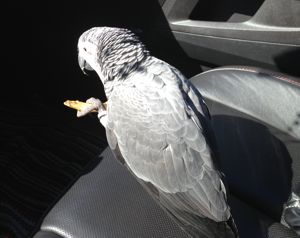
She flew back up front and stayed on my shoulder until we got home. Once home, I put Angel in one of our cages - she had a few pieces of apples and settled down. Then the good news came!!!! The girls at work found an electronic ad from Angel's family desperate to find her. Long story short Angel is back with her family. :)
The Lord answers our prayers in unusual ways sometimes. I had no intention on heading down to Wendy's for lunch - it was very last minute. When leaving Wendy's I saw a bird struggling to fly up to the telephone lines near Burger King. I quickly recognized that the bird was a Parrot. I turned around and went back to Burger King to check it out. Had I not gone to Wendy's for some unhealthy food......who knows where Angel would be. Such a great story with such a great ending! So happy the Beatty family have their sweet Angel back home safe and sound.
P.S. None of these pics were taken while I was driving.
DiAnne works at Cannon Design on Grand Island and while she was handling Angel, a co-worker was searching the internet and found the Lost Bird notice on Isledegrande. Link to thank you from Angel's family on the Letters to the Editor page.
My Wonderful Week
By Lenore Tetkowski - 4/4/13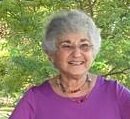
When I was handed the award envelope for having won the "People's Choice" at our last Weavers' Guild of Buffalo Exhibit, I was very pleased, and expected a more typical little gift. I won a week's tuition at the John C. Campbell Folk School in North Carolina! It would be valid for a year, so I studied the catalog a long time. When I decided on Anita Luvera Mayer's workshop and sent in my registration information, I was called and informed that it was cancelled! It may surprise you that then I chose "Creative Nonfiction Writing". A big part of the whole experience was getting there. I flew into Atlanta as recommended and was met by the Folk School van's friendly driver. We chatted and I dozed on the two-hour drive north. The School is 5 miles from Tennessee and five miles from Georgia in the southwest little blip of North Carolina deep in Appalachia. After a warm welcome I gradually mingled with all the other creative folks, and enjoyed a big attractive delicious dinner together. All the meals were outstanding with a vegetarian buffet in addition to regular fare. We were encouraged to eat with different groups at each meal to get to know everybody. I shared a lovely room in a cottage with a roommate from South Carolina taking painting. Classes were spread out in studios over the campus-like grounds. I enjoyed walking on woodland paths and visited most of them.
Everyone was welcome to take part in early morning folk singing accompanied by banjo or guitar or fiddle, late afternoon programs and evening programs. So I got to experience lots besides my actual writing course. There was traditional "Broom Making", "Blacksmithing", "Stained Glass", "Glass Bead Making", "Beginning Guitar" and "Quilting", "Painting", "Tapestry Basics", "Woodcarving" and "Building a Dulcimer". Tommye McClure Scanlin is an accomplished tapestry weaver, who told me she would be interested in doing a workshop for our Guild. Each week the program varies. There were three men with me in our writing class with an excellent teacher, Carol Crawford. She had a way of getting us to write personal essays and getting rich feedback from each other. Each member was unique and we really bonded by the end of the week. When they realized how old I am, they strongly encouraged me to continue to write my memoirs.
This Folk School provides a unique way to develop inner creative growth and social development as caring members of a community. It is a non-competitive, peaceful, beautiful, supportive interlude in this hyperactive world. Many thanks to the Weavers' Guild of Buffalo for providing this week for me.




